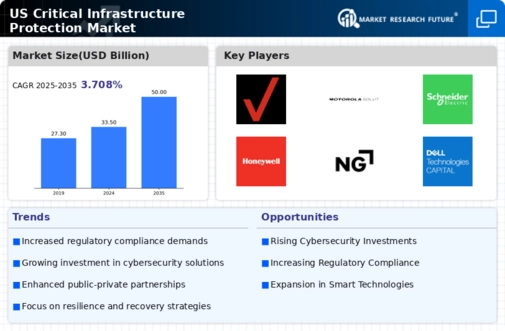Rising Public Awareness
Public awareness regarding the importance of critical infrastructure protection is steadily increasing, influencing market dynamics. As citizens become more informed about potential threats, there is a growing demand for transparency and accountability from organizations responsible for critical services. This heightened awareness drives companies to invest in security measures that not only protect their assets but also reassure the public. In 2025, surveys indicate that over 70% of Americans prioritize the security of essential services, prompting businesses to enhance their protective strategies. Consequently, the critical infrastructure-protection market is likely to expand as organizations strive to meet public expectations and regulatory requirements.
Growing Threat Landscape
The evolving threat landscape in the United States is a primary driver for the critical infrastructure-protection market. With the rise of cyberattacks, physical threats, and natural disasters, organizations are compelled to enhance their security measures. In 2025, it is estimated that cybercrime will cost the global economy over $10 trillion annually, prompting increased investment in protective technologies. This urgency to safeguard critical assets leads to a surge in demand for advanced security solutions, including surveillance systems, access controls, and incident response services. As threats become more sophisticated, the critical infrastructure-protection market is required to adapt, ensuring that protective measures are robust and comprehensive. Organizations are likely to allocate more resources to address these challenges, thereby driving market growth.
Technological Advancements
Technological advancements are reshaping the critical infrastructure-protection market, offering innovative solutions to address emerging threats. The integration of artificial intelligence, machine learning, and the Internet of Things (IoT) is revolutionizing security protocols, enabling real-time monitoring and response capabilities. In 2025, the market for AI-driven security solutions is projected to reach $30 billion, reflecting the growing reliance on technology to enhance protection measures. These advancements not only improve efficiency but also reduce operational costs, making them attractive to organizations across various sectors. As technology continues to evolve, the critical infrastructure-protection market is expected to adapt, incorporating cutting-edge solutions to safeguard vital assets.
Increased Regulatory Scrutiny
Increased regulatory scrutiny is a significant driver of the critical infrastructure-protection market. Regulatory bodies are implementing stricter guidelines and standards to ensure the safety and security of critical infrastructure. For example, the Federal Energy Regulatory Commission has introduced new regulations aimed at enhancing the cybersecurity posture of energy providers. Organizations are now required to comply with these regulations, leading to a surge in demand for compliance solutions and services. This trend is likely to continue, as non-compliance can result in hefty fines and reputational damage. Consequently, the critical infrastructure-protection market is poised for growth as organizations invest in compliance-related technologies and services.
Government Initiatives and Funding
Government initiatives play a crucial role in shaping the critical infrastructure-protection market. In recent years, federal and state governments have recognized the importance of securing critical infrastructure, leading to increased funding and support for protective measures. For instance, the Department of Homeland Security has allocated billions of dollars to enhance the resilience of critical sectors, including energy, transportation, and healthcare. This financial backing not only encourages private sector investment but also fosters collaboration between public and private entities. As a result, the critical infrastructure-protection market is likely to experience significant growth, driven by government mandates and funding opportunities aimed at bolstering national security.






















Leave a Comment